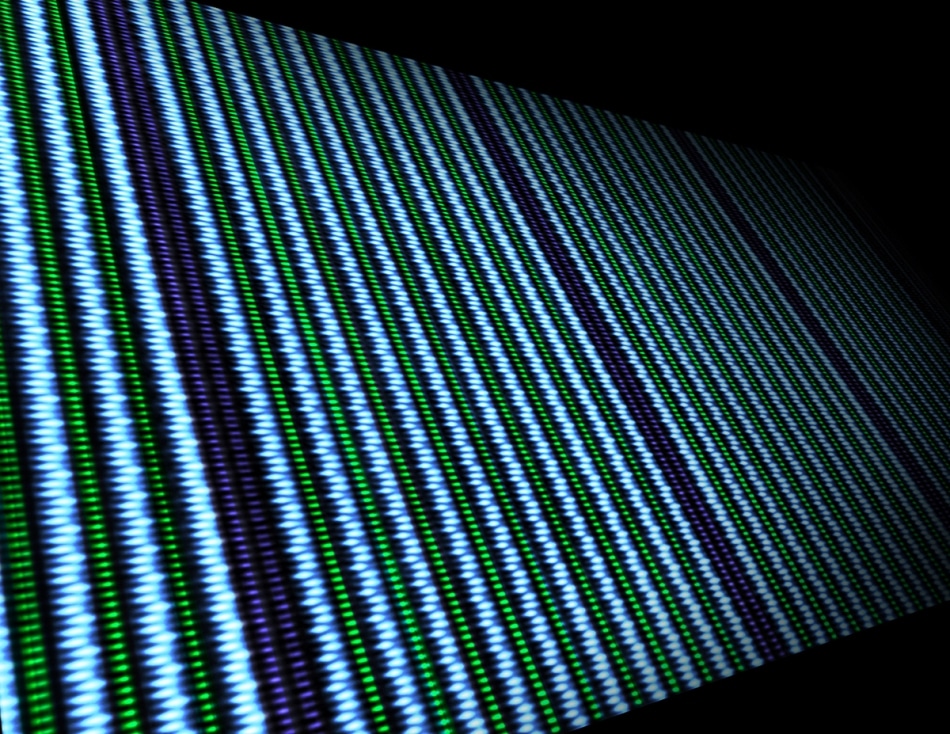Sep 23 2016
 The magnetoelectric multiferroic created by a group led by Julia Mundy, a former Cornell postdoctoral researcher now at the University of California, Berkeley. The double strand of purple represents the extra layer of iron oxide, which makes the material a multiferroic at near room temperature. (Credit: Julia Mundy)
The magnetoelectric multiferroic created by a group led by Julia Mundy, a former Cornell postdoctoral researcher now at the University of California, Berkeley. The double strand of purple represents the extra layer of iron oxide, which makes the material a multiferroic at near room temperature. (Credit: Julia Mundy)
Multiferroics or materials that posses both electric and magnetic order are the main areas of focus for futuristic computing. However, as the conditions conducive for these two states are mutually exclusive, these multiferroics are hard to create. Most of the multiferroics known currently only exhibit their properties at very low temperatures.
Two years ago, a group of researchers from the labs of Darrell Schlom, the Herbert Fisk Johnson Professor of Industrial Chemistry in the Department of Materials Science and Engineering, and Dan Ralph, the F.R. Newman Professor in the College of Arts and Sciences, collaborated with UC Berkeley’s professor Ramamoorthy Ramesh to study multiferroics, and published a paper detailing their work.
The researchers achieved groundbreaking results involving the multiferroic bismuth ferrite, which is the only known material where applying an electric field at room temperature can provide control of magnetism.
Schlom’s team have taken the research to the next step with the help of David Muller and Craig Fennie, who are professors of applied and engineering physics. The scientists have created a new room-temperature multiferroic by merging two non-multiferroic materials, using their best properties.
The September 22 issue of Nature has published the team’s paper titled ‘Atomically engineered ferroic layers yield a room-temperature magnetoelectric multiferroic,’ with a news and views piece. The paper is authored by Julia Mundy, Ph.D. ’14, a former doctoral student working jointly with Muller and Schlom who is now a postdoctoral researcher at the University of California, Berkeley; Charles Brooks, Ph.D., a visiting scientist in the Schlom group; and Megan Holtz, a doctoral student in the Muller group.
Thin films of lutetium iron oxide (LuFeO3), a material with robust ferroelectric but poor magnetic properties, were engineered by the researchers. Unlike a strong ferrimagnetic oxide like LuFe2O4, which consists of alternating double monolayers of iron oxide with monolayers of lutetium oxide, the LuFeO3 consists of alternating single monolayers of iron oxide and lutetium oxide.
The team discovered that these two materials could be combined at the atomic level to form a new compound that is both multiferroic and had better properties than either of the original constituents. They also found that they required only one extra monolayer if iron oxide has to be added at every 10 atomic repeats of the LuFeO3 to bring about significant changes in the system’s properties.
Precision engineering was performed using molecular-beam epitaxy (MBE), which the Schlom lab specializes in. This is a technique that allows scientists to design and assemble two materials in layers, one atom at a time. Schlom compares MBE to “atomic spray painting.”
When combined, these two materials formed a strong ferrimagnetic layer at room temperature. The new material was then tested at the Lawrence Berkeley National Laboratory (LBNL) Advanced Light Source, with the help of co-author Ramesh. The test was conducted to demonstrate that when switched by an electric field, the ferrimagnetic atoms maintained the placement of their ferroelectric neighbors.
It was when our collaborators at LBNL demonstrated electrical control of magnetism in the material that we made that things got super exciting. Room-temperature multiferroics are exceedingly rare and only multiferroics that enable electrical control of magnetism are relevant to applications.
Darrell Schlom, Professor, Cornell University
Multiferroics have the property of reversible polarization which emerges as a reaction to low-power electric fields, rather than to heat-generating electrical currents that consume power. This and their ability to hold their polarized position with little power are the major advantages of multiferroics when they are used in electronic devices.
Our work shows that an entirely different mechanism is active in this new material, giving us hope for even better – higher-temperature and stronger – multiferroics for the future.
Darrell Schlom, Professor, Cornell University
The collaborators of the study belong to various universities including the University of Illinois at Urbana-Champaign, the National Institute of Standards and Technology, the University of Michigan and Penn State University.
The U.S. Department of Energy’s Office of Basic Energy Sciences, Division of Materials Science and Engineering provided the financial support for the study. The Cornell NanoScale Science and Technology Facility, a member of the National Nanotechnology Coordinated Infrastructure that is supported by National Science Foundation (NSF), was used for substrate preparation.
The Cornell Center for Materials Research, a Materials Research Science and Engineering Center also supported by the NSF provided electron microscopy support for imaging of the atomic structures.